Sustainable soil amendment using waste-derived biochar against climate changes
Climate change is getting worse across the globe

(https://unsplash.com/photos/DwtX9mMHBJ0)
Climate change is defined as long term-shifts in temperatures and weather patterns by the United Nations. The major cause of climate change is attributed to excessive emissions of greenhouse gases, which involve methane (CH4), nitrous oxides (NOx) and, especially, carbon dioxide (CO2). These greenhouse gases can entrap the radiation emitted from the surface of the Earth and reflect it back to the Earth, which substantially increases atmospheric temperature. With the soaring human activities including consumption of fossil fuels and engineering construction, the atmospheric CO2 level and temperature increases are expected to reach 1100ppm (i.e., 2.5 times of the current level) and 4°C in 2100, respectively, according to IPCC (2013). The rising temperature consequently triggers more extreme weather events, such as torrential rain, typhoon, flooding, heat wave, snowstorm, drought, etc., which threaten human life and even natural environment. Under severe climate change, some earthen structures including landfill soil covers and man-made slopes are subjected to a higher risk of failure. For instance, drought can initiate desiccation cracks on soil surface and damage the functionality of soil covers while the torrential rain can reduce soil strength and cause slope instability. More importantly, ecological systems are becoming more vulnerable to degradation, defaunation as well as fragmentation because of climate change. Over one-third of animals and plant species in the world are facing potential extinction. Every country is now committed to incorporate sustainability into social development in order to relieve climate change and preserve the Earth.
Biochar, “a black diamond” to relieve climate change by sequestrating carbon
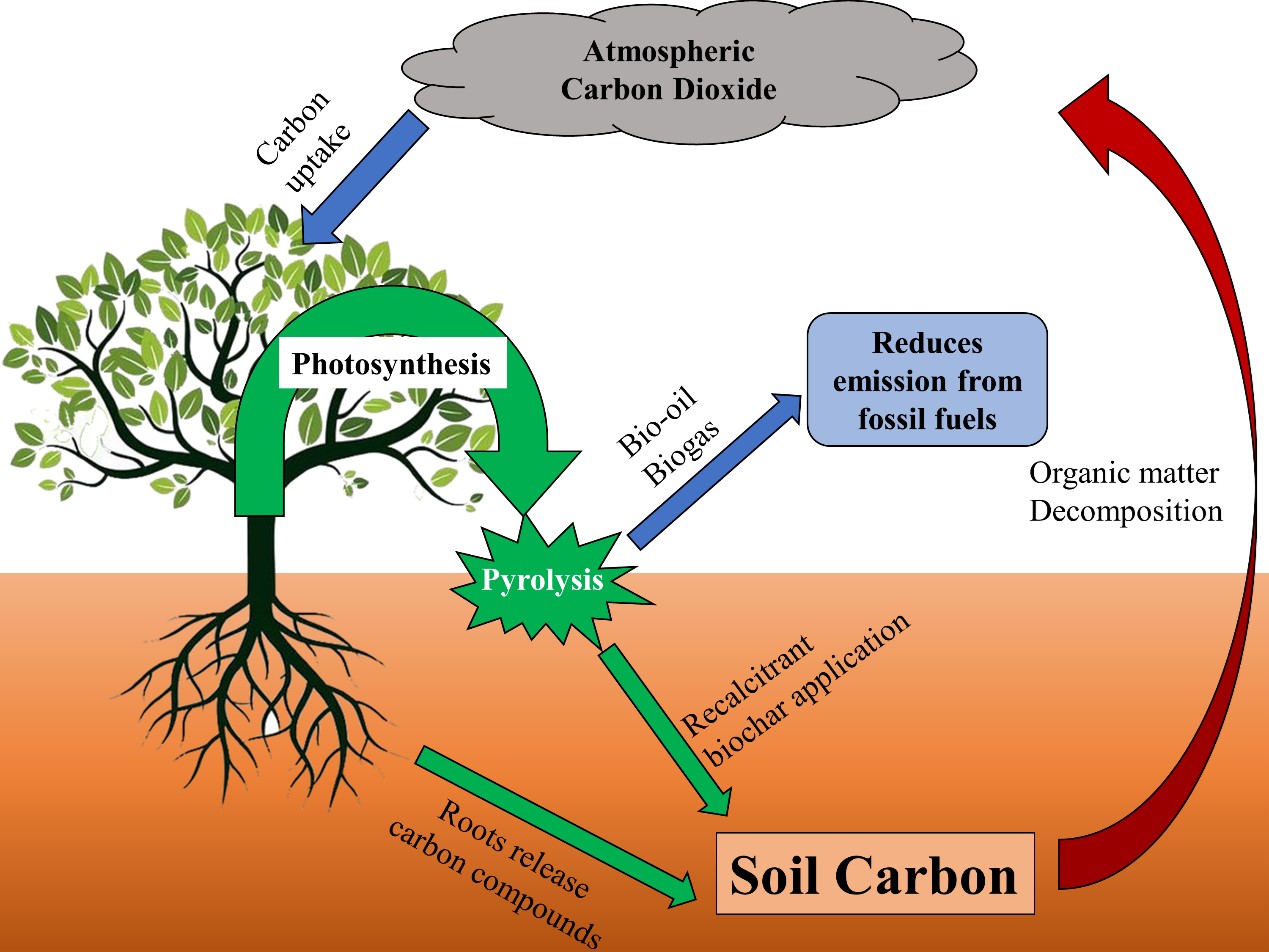
To fundamentally solve the problems of climate change, one of the most popular and effective strategies is to capture and store atmospheric CO2. Such process is called carbon sequestration which can be implemented geologically and biologically. Geological carbon sequestration is the process of injecting supercritical CO2 fluid into soil and rocks in basins and sea. On the other hand, biological carbon sequestration normally refers to storage of atmospheric CO2 in terrestrial and aquatic plants. In recent years, biological carbon sequestration is usually preferred, which can simultaneously contribute to greening of cities. However, the carbon stored in plants can be released back to the atmosphere when plant residues are decomposed. To stabilise and lock the carbon in the long run, the plant residues can be pyrolyzed anaerobically at the temperature typically between 300°C and 700°C to form carbon-rich products called biochar. During the pyrolysis process, bio-oil and biogas are also produced as by-products for energy production, thereby reducing CO2 emission due to consumption of fossil fuel. It is estimated that carbon sequestrated in the form of biochar is stable over thousands of years. Biochar itself also has economic value. It can be used to sustainably amend soil for different engineering applications. Owing to its large surface area, it can be applied in landfill covers and contaminated soil to reduce odour emissions and absorb pollutants, respectively. Besides, biochar can serve as sustainable fertilizers to stimulate plant growth and even achieve ecological restoration by improving soil properties and micro-ecological environment. When plants grow better, they are more capable of capturing atmospheric CO2 for photosynthesis. The plant root exudates, which are sources of liable soil carbon, can also be stabilised through the interactions with biochar to become a more recalcitrant form. Furthermore, the presence of biochar in the amended soil can inhibit the decomposition of soil organic carbon by microbial activities. All these processes are attributed to soil-biochar-plant interactions (Fig. 1) which can benefit carbon sequestration and alleviate climate change. It is obvious that biochar-amended soil improves plant growth, which can achieve ecological restoration such as large-scale afforestation and reforestation. Soil with vegetation also has a greater resistant to erosion and minimise the cost of maintaining slopes. The use of biochar as a soil amendment not only facilitates carbon sequestration against climate change, but also encourages the development of sustainable engineering applications.
Types of biochar produced using different feedstocks
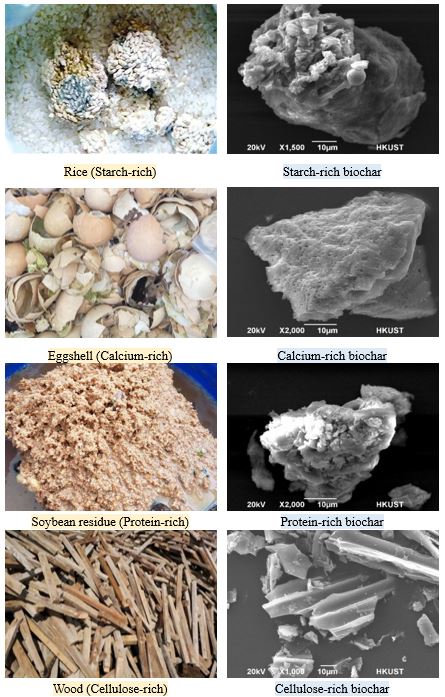
In addition to plant residues, various types of biochar can be produced using different feedstocks, such as food waste. This leads to huge differences in biochar properties and induces different plant response after mixing different biochar with soil. When agricultural waste, such as plant residues, is used for biochar production, this biochar type is called cellulose-rich biochar since cellulose is the major chemical composition of both feedstock and biochar. Although this type of biochar is widely used for soil amendment due to the readily available agricultural waste, a lack of nutrients, such as nitrogen, calcium, and phosphorus, in this biochar may not be the best choice to be adopted for vegetated soil. As plants require nutrients to grow properly and efficiently, other feedstocks obtained from municipal solid wastes, especially for food waste, are also considered and converted to biochar. Based on the properties of feedstocks, the biochar types can be classified into starch-rich biochar (e.g., rice and bread), Ca-rich biochar (e.g., fish bone and eggshell), protein-rich biochar (e.g., soybean), cellulose-rich biochar (e.g., wood logs and leaves), etc. For example, using nitrogen-rich biochar can supply soil with nitrogen to strike a balance between soil carbon and nitrogen cycling for improving plant growth and enhancing carbon sequestration by plants in order to fight against climate change (Yin et al., 2021). The appearance of the feedstocks and microstructure of different biochar produced from them are shown in Fig. 2. As feedstocks would greatly affect the chemical properties of biochar products, scientists over the world are actively engaging in investigating effects of different biochar types on soil properties as well plant response.
Application of biochar to soil for ecological restoration of degraded land
Degraded land, such as landfills and quarries, needs to be restored and upgraded to improve its ecological values and promote sustainability in society. The process of repairing degraded sites and restoring their biological functions is called ecological restoration. In general, complete ecological restoration can take years, decades, or even centuries. For instance, we can initiate a forest restoration process by planting trees, but it is a long-term process for this site to become a fully functioning forest. Normally, biochar application improves soil quality by re-establishing microbial communities and soil-water holding capacity. As a result, plant growth can be improved, which helps to recreate ecological function of the soil and shorten the restoration time. Compared with traditional remediation technique, applying biochar can also reduce costs of ecological restoration significantly (Chukwuka et al., 2020). The benefits of biochar bringing to plant growth from the perspectives of soil-microbial communities and soil-water holding capacity are explained as follows:
1. Effects of biochar on microbial communities in soil
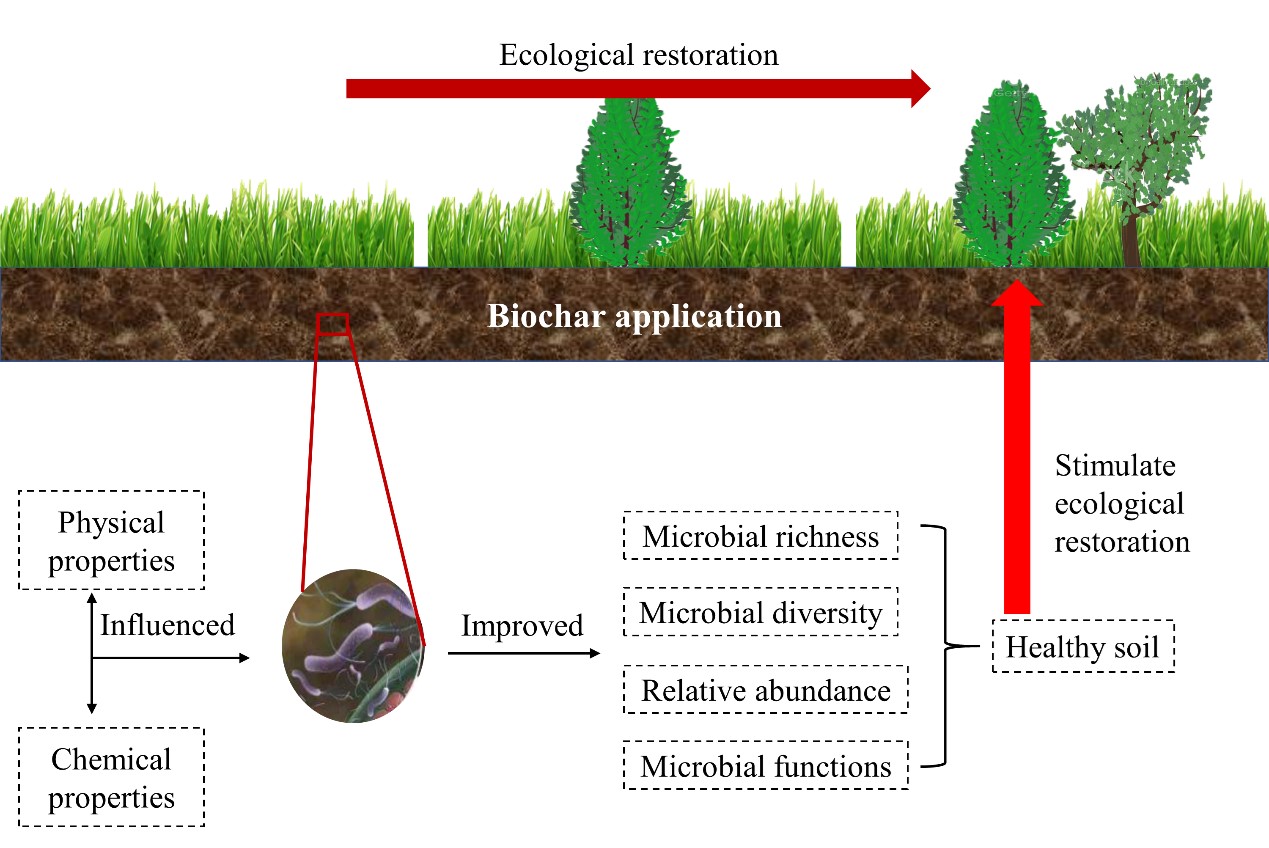
Soil microorganisms are the major factor to evaluate the degree of ecological restoration since they provide essential ecosystem services. Biochar amendment provides suitable soil environment, such as soil nutrients, for the growth of microbes. The presence of biochar also facilitates the uptake of water and nutrients by soil microorganisms, leading to an increase in microbial biomass. On the other hand, the pore of biochar provides a shelter for soil microbes to avoid predators. Consequently, the abundance of beneficial bacteria in the microbial community as well as microbial diversity are usually enhanced. The greater microbial diversity also implies that the microorganisms can provide versatile functions in soil, such as nutrient cycling and enzyme activities. The enhanced bacterial/soil functions after biochar addition can eventually improve plant growth and stimulate vegetation establishment (Fig. 3). However, due to the large variations in physical and chemical properties of biochar derived from different feedstocks and manufacturing processes, similar effects on soil biota cannot be guaranteed without identifying the underlying interactions between soil-microbes and biochar. Engaging research is still on-going to determine how biochar application can efficiently favour the establishment of an ecosystem.
2. Effects of biochar on hydro-chemical properties of soil for plant growth
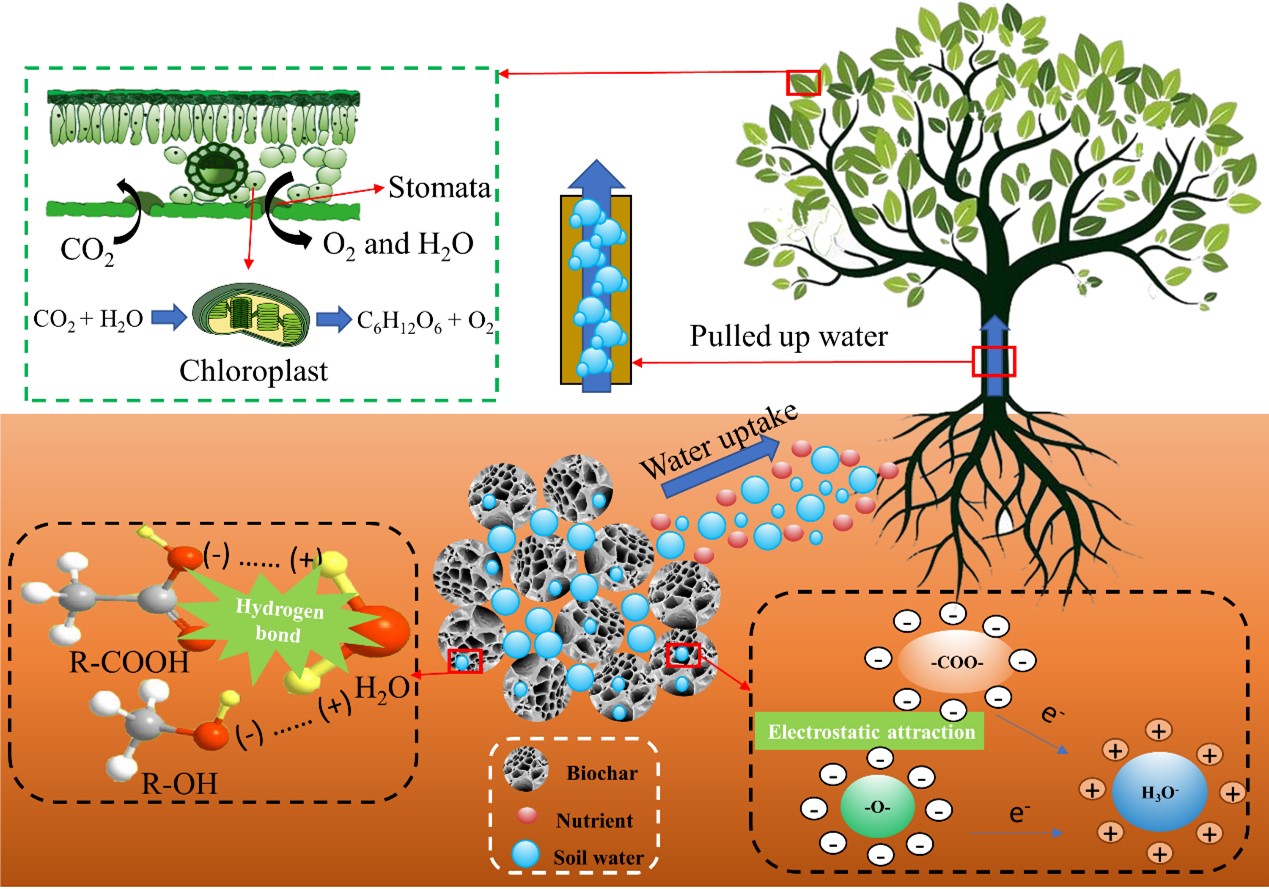
Soil water content is considered as one of the most important factors influencing soil nutrient availability and plant performance. Addition of biochar allows higher soil water retention and leads to a more efficient use of rain or irrigation water to optimise plant growth. The soil water retention improved by biochar is attributed to those water molecules stored inside micropores of biochar. There are also two ways through which water molecules can bond on the surface of biochar. The surface polar functional groups, such as carboxyl and hydroxyl, can retain water through hydrogen bond. While water can be bonded by the polar functional groups, such as carbonyl and oxygen through Van der Waals forces. Thus, water stored in the biochar-amended soil can be absorbed by plant roots. Roots will transfer those water to the xylem of the plant and then reach the plant leaves. In the leaves, plants can use the water for two major metabolic activities. Firstly, the water vapor will be transferred to the atmosphere through stomata to lower the plant body temperature. Secondly, the water can also be consumed to produce sugar for plant growth in chloroplast. In general, biochar addition will influence soil water retention property and then lead to the change in the plant water use efficiently (Fig. 4). On the other hand, biochar itself provides nutrients, such as nitrogen (N), phosphorus (P), potassium (K), and trace elements, for plant growth. When biochar is used together with chemical fertilisers, it helps to reduce the leaching of soil nutrients because the large surface area of biochar can absorb nutrients and slowly release them in the soil (Rawat et al., 2019). All these benefits of biochar addition to soil consequently improve plant growth and promote ecological restoration effectively.
Incorporation of sustainability into green slope engineering using biochar
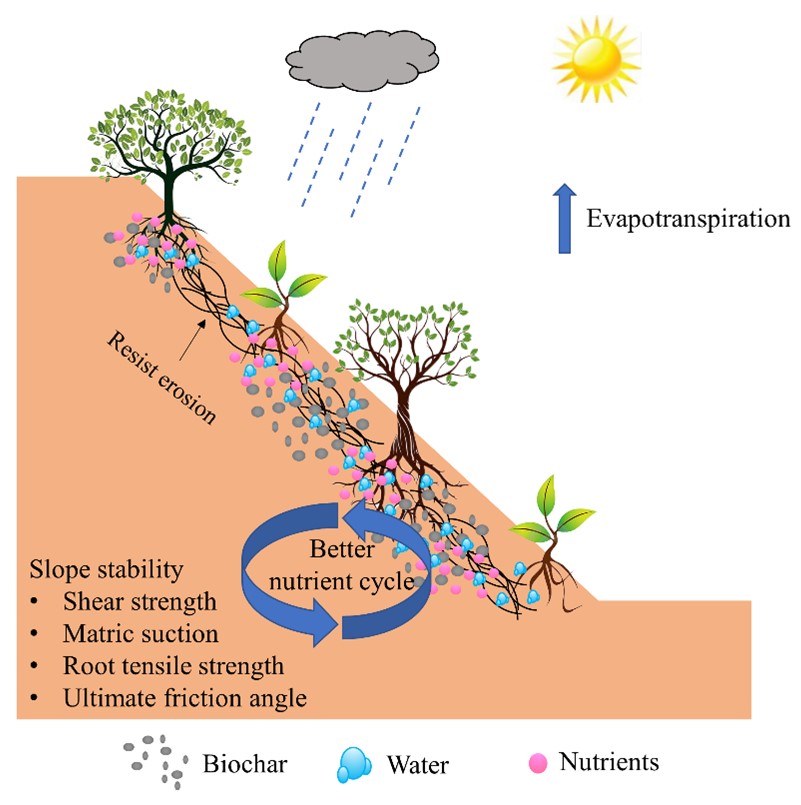
Apart from ecological restoration, potential applications of biochar in earthen structures, such as green slopes, are drawing great attention from geologists and geotechnical engineers. This aims to achieve stability, sustainability, and low maintenance with the use of biochar. The major principle of slope stabilised by vegetation, which is called green slope engineering, is based on the root reinforcement and plant transpiration. One obvious benefit of applying biochar to vegetated slopes is providing extra water and nutrients for the growth of plant roots. Once plant roots become stronger, the resistant force contributed by root tensile strength is enhanced. Thus, stability of vegetated slopes can be further improved due to the coupled interactions between biochar and plants. On the other hand, biochar application promotes plant growth and, thus, plant transpiration, which reduces water content in soil and increases the soil shear strength as well as slope stability (Fig. 5). Although biochar is a fragile material which is crushable, its application in soil would not reduce the soil strength. For this concern, Ng et al. (2022) has provided the answers. This team applied different biochar types including peanut shell and wood biochar in soil to investigate their effects on soil shear strength. Their study found that 5% biochar application in the soil maintained similar ultimate strength as the soil without biochar added. This indicates that biochar itself should not have negative effects on soil strength and slope stability. For details of biochar effects on soil shear strength, please check the link.












